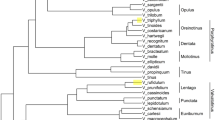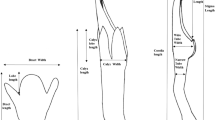Abstract
Because highly invasive species can rapidly assimilate rare taxa, we questioned whether two Florida endangered Lantana depressa varieties existed 21 years after Sanders documented their widespread hybridization with exotic Lantana strigocamara, and whether morphological traits could accurately discriminate genetic individuals. Stepwise discriminant analysis of morphological characters discriminated the three taxa, correctly classifying 98, 91, 89% of L. strigocamara, L. depressa var. depressa, and var. floridana. Hybrids blurred taxonomic distinctions of varieties and reduced classification accuracy by 7–17%. Species-specific Random Fragment Length Polymorphism (RFLP-PCR) confirmed hybridization has occurred. Intersimple Sequence Repeat (ISSR) fingerprints analyzed with STRUCTURE identified three groups indicating introgression. Morphological traits significantly, but weakly correlated with q ratios (P = 0.0001; r 2 = 0.45). Although L. strigocamara introgression is widespread and ongoing, wild populations contain individuals that are predominantly L. depressa genome, supporting actions to remove adventive L. strigocamara, prevent its sale, and promote sales of genetically confirmed natives.





Similar content being viewed by others
References
Allendorf FW, Leary RF, Spruell P, Wenburg JK (2001) The problems with hybrids: setting conservation guidelines. Trends Ecol Evol 16:613–622
Alvarez I, Wendel JF (2003) Ribosomal ITS sequences and plant phylogentic inference. Mol Phylogenet Evol 29:417–434
Arnold ML (1992) Natural hybridization as an evolutionary process. Annu Rev Ecol Syst 23:237–261
Arnold ML (1997) Natural hybridization and evolution. Oxford University Press, New York
Broschat TK, Meerow AW (1991) Betrock’s guide to Florida landscape plants. Betrock Information Systems, Hollywood
Cattell MV, Karl SA (2004) Genetics and morphology in a Borrichia frutescens and B. arborescens (Asteraceae) hybrid zone. Am J Bot 91:1757–1766
Coile NC (2000) Notes on Florida’s endangered and threatened plants, 3rd edn. Florida Department of Agriculture and Consumer Services, Division of Plant Industry, Bureau of Entomology, Nematology and Plant Pathology, Botany section. Contribution No. 38
Cruzan MB, Arnold ML (1994) Assortative mating and natural selection in an Iris hybrid zone. Evolution 48:1946–1958
Dehnen-Schmutz K, Touza J, Perrings C, Williamson M (2007) A century of the ornamental plant trade and its impact on invasion success. Divers Distrib 13:527–534
Esselman EJ, Jianqiangt L, Crawford DJ, Windus JL, Wolfe AD (1999) Clonal diversity in the rare Calamagrostis proteri spp. insperata (Poaceae): comparative results for allozymes and RAPD and ISSR markers. Mol Ecol 8:443–451
Evanno G, Regnaut S, Goudet J (2005) Detecting the number of clusters of individuals using the software STRUCTURE: a simulation study. Mol Ecol 14:2611–2620
Francisco-Ortega J, Santo-Guerra A, Kim S, Crawford DJ (2000) Plant genetic diversity in the Canary Islands: a conservation perspective. Am J Bot 87:909–919
Fuertes Aguilar J, Rossello JA, Nieto Feliner G (1999) Nuclear ribosomal DNA (nrDNA) concerted evolution in natural and artificial hybrids of Armeria (Plumbaginaceae). Mol Ecol 8:1341–1346
Hammer R (1997) Postcards from paradise. Wildland Weeds 1:4–5
Lau CPY, Ramsden L, Saunders RMK (2005) Hybrid origin of Bauhinia bladeana (Leguminosae: Caesalpinioideae), inferred using morphological, reproductive, and molecular data. Am J Bot 92:525–533
Levin DA (2000) The origin, expansion, and demise of plant species. Oxford University Press, New York
Lowe S, Browne M, Boudjelas S, De Poorter M (2000) 100 of the world’s worst invasive alien species: a selection from the global invasive species database. Invasive Species Specialist Group. IUCN, Auckland
Mathur G, Ram HYM (1986) Floral biology and pollination of Lantana camara. Phytomorphology 36:79–100
Nason JD, Ellstrand NC, Arnold ML (1992) Patterns of hybridization and introgression in populations of oaks, manzanitas and irises. Am J Bot 79:101–111
Palmer WA, Pullen KR (1995) The phytophagous arthropods associated with Lantana camara, L. hirsuta, L. urticifolia, and L. urticoides (Verbenaceae) in North America. Biol Control 5:54–72
Pritchard JK, Stephens M, Donnely P (2000) Inference of population structure using multilocus genotype data. Genetics 155:945–959
Rhymer JM, Simberloff D (1996) Extinction by hybridization and introgression. Annu Rev Ecol Syst 27:83–109
Rieseberg LH (1995) The role of hybridization in evolution: old wine in new skins. Am J Bot 82:944–953
Rieseberg LH, Ellstrand NC (1993) What can molecular and morphological markers tell us about plant hybridization? Crit Rev Plant Sci 12:213–241
Rosenfield JA, Nolasco S, Lindauer S, Sandoval C, Kodric-Brown A (2004) The role of hybrid vigor in the replacement of pecos pupfish by its hybrids with sheepshead minnow. Conserv Biol 18:1589–1598
Sahu AK, Panda S (1998) Population dynamics of a few dominant plant species around industrial complexes in West Bengal, India. Bombay Nat Hist Soc J 95:15–18
Sanders RW (1987a) Identity of Lantana depressa and L. ovatifolia (Verbenaceae) of Florida and the Bahamas. Syst Bot 12:44–60
Sanders RW (1987b) Taxonomic significance of chromosome observations of Caribbean species of Lantana (Verbenaceae). Am J Bot 74:914–920
Sanders RW (2006) Taxonomy of Lantana sect. Lantana (Verbenaceae): I. Correct application of Lantana camara and associated names. Sida 22:381–421
Schemske DW (2000) Understanding the origin of species. Evolution 54:1069–1073
Scott LJ, Graham GC, Hannan-Jones M, Yeates DK (1997) DNA Profiling resolves the limited importance of flower colour in defining varieties of Lantana camara. Electrophoresis 18:1560–1563
Sharma GP, Raghubanshi AS, Singh JS (2005) Lantana invasion: an overview. Weed Biol Manag 5:157–165
Spies JJ (1983) Hybridization potential of Lantana camara (Verbenaceae). Garcia de Orta Serie Botanica 6:145–150
Spies JJ (1984) A cytotaxonomic study of Lantana camara (Verbenaceae) from South Africa. S Afr J Bot 3:231–250
Stebbins GL (1950) Variation and evolution in plants. Columbia University Press, New York
Stirton CH (1977) Some thoughts on the polyploid complex Lantana camara (Verbenaceae). In: Annecke DP (ed) Proceedings of the 2nd national WEEDS conference of South Africa, Balkema, SA, pp 321–340
Swarbrick JT, Willson BW, Hannan-Jones MA (1998) Lantana camara L. In: Panetta FD, Groves RH, Shepherd RDH (eds) The biology of Australian weeds. RG& E J Richardson, Melbourne, pp 110–136
SYSTAT 10.2 Statistics II (2002) SYSTAT Software Inc. Richmond
Tassin J, Triolo J, Lavergne C (2007) Ornamental plant invasions in mountain forests of Reunion (Mascarene Archipelago): a status review and management directions. Afr J Ecol 45:444–447
Tiebre MS, Bizoux JP, Hardy OJ, Bailey JP, Mahy G (2007) Hybridization and morphogenetic variation in the invasive alien Fallopia (Polygonaceae) complex in Belgium. Am J Bot 94:1900–1910
Tovar-Sánchez E, Oyama K (2004) Natural hybridization and hybrid zones between Quercus crassifolia and Quercus crassipes (Fagaceae) in Mexico: morphological and molecular evidence. Am J Bot 19:1352–1363
Travis SE, Baggs JE, Maschinski J (2007) Disentangling the role of hybridization in the evolution of the endangered Arizona cliffrose (Purshia subintegra: Rosaceae): a molecular and morphological analysis. Conserv Genet 9:1183–1194
Vincze T, Posfai J, Roberts RJ (2003) NEBcutter: a program to cleave DNA with restriction enzymes. Nucleic Acids Res 31:3688–3691
White TJ, Bruns T, Lee S, Taylor JW (1990) Amplification and direct sequencing of fungal ribosomal RNA genes for phylogenetics. In: Innis MA, Gelfand DH, Sninsky JJ, White TJ (eds) PCR protocols: a guide to methods and applications. Academic Press, Inc, New York, pp 315–322
Whitham TG, Maschinski J (1996) Current hybrid policy and the importance of hybrid plants in conservation. In: Maschinski J, Hammond HD, Holter L (eds) Southwestern rare and endangered plants: proceedings of the second conference, Flagstaff, AZ, 11–14 September 1995. General technical report RM-GTR-283. U.S. Department of Agriculture, Forest Service, Rocky Mountain Forest and Range Experiment Station, Fort Collins, pp 103–112
Wolf DE, Takebayashi N, Rieseberg LH (2001) Predicting the risk of extinction through hybridization. Conserv Biol 15:1039–1053
Wolfe AD, Wian QY, Kephart SR (1998a) Diploid hybrid speciation in Penstemon (Scrophulariaceae). Proc Natl Acad Sci USA 95:5112–5115
Wolfe AD, Xiang Q, Kephart SR (1998b) Assessing hybridization in natural populations of Penstemon (Scrophulariaceae) using hypervariable intersimple sequence repeat (ISSR) bands. Mol Ecol 7:1107–1125
Wunderlin RP (1998) Guide to the vascular plants of Florida. University Press of Florida, Gainesville
Wunderlin RP, Hansen BF (2003) Guide to the vascular plants of Florida, 2nd edn. University Press of Florida, Gainesville
Acknowledgments
We dedicate this paper to the memory of Kathy Burks, an extraordinary native plant conservation advocate in Florida, who suggested we conduct this research. This work was funded by Florida Department of Agriculture and Consumer Services Division of Plant Industry Contracts #007997 and #009064. For assistance in the field and laboratory, we sincerely thank G. Gann, J. Possley, C. & D. Walters, C. Ettore, M. Petersen, B. Horwith, and A. Cantillo. We thank Javier Francisco-Ortega, the editor, and one anonymous reviewer for helpful comments on the manuscript.
Author information
Authors and Affiliations
Corresponding author
Rights and permissions
About this article
Cite this article
Maschinski, J., Sirkin, E. & Fant, J. Using genetic and morphological analysis to distinguish endangered taxa from their hybrids with the cultivated exotic pest plant Lantana strigocamara (syn: Lantana camara). Conserv Genet 11, 1607–1621 (2010). https://doi.org/10.1007/s10592-009-0035-6
Received:
Accepted:
Published:
Issue Date:
DOI: https://doi.org/10.1007/s10592-009-0035-6




